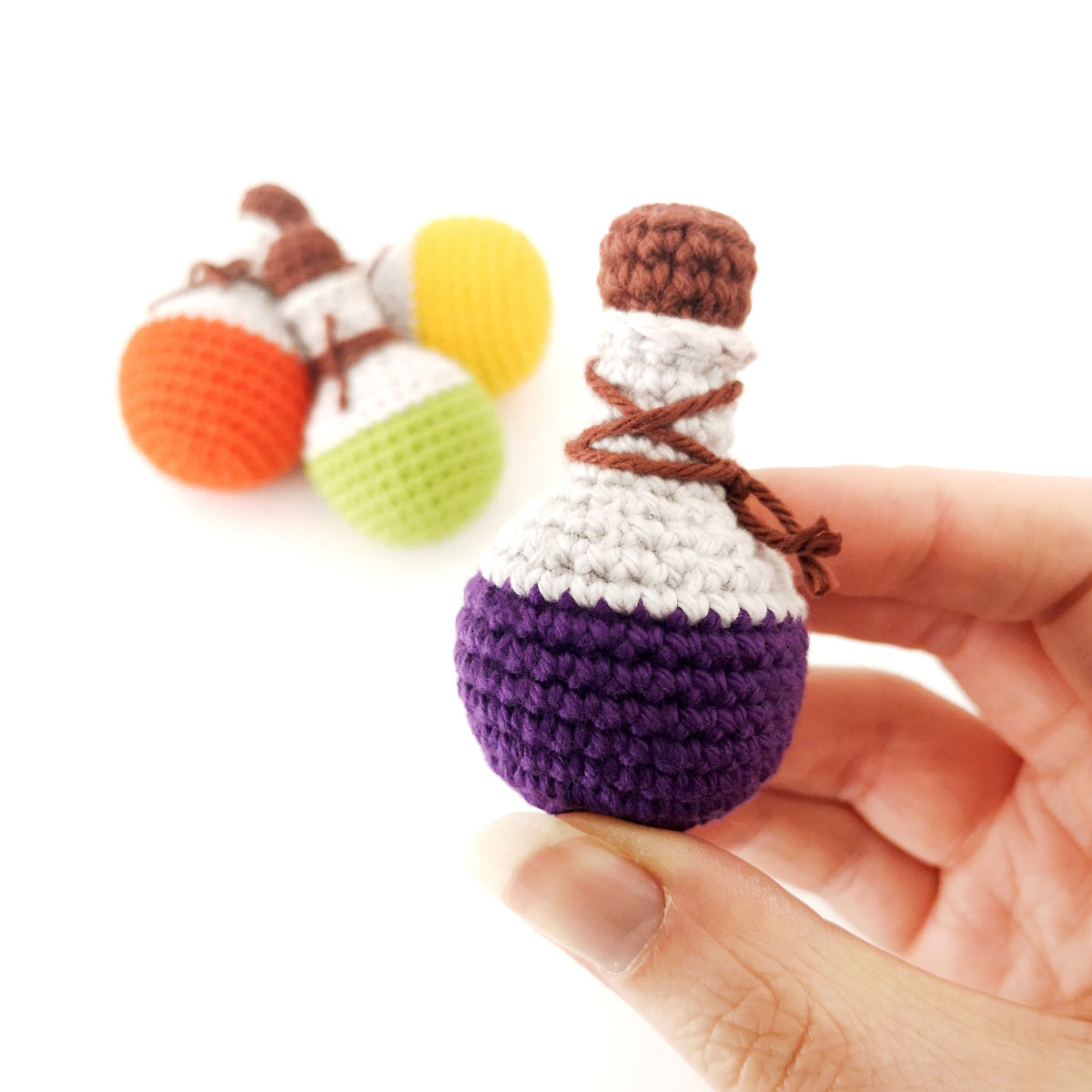Add a whimsical touch with this mini potion bottle crochet pattern! Perfectly sized for a keychain, these tiny bottles also make charming centerpieces or decorative bowl fillers. Keep reading!
MATERIALS
- DK weight yarn in light grey, dark brown, and your chosen potion color (I used Paintbox Yarns Cotton DK in Misty Grey, Coffee Bean, and Blood Orange/Lime Green/Buttercup Yellow/Rich Mauve)
- 2.5mm crochet hook
- Polyester fiberfill
- Optional: Small charms or beads for decoration
- Stitch marker, yarn needle, scissors
ABBREVIATIONS
- ch – chain
- sc – single crochet
- inc – increase
- invdec – invisible decrease
- BLO – back loop only
- sl st – slip stitch
- st/s – stitch/es
- […] – repeat instructions within brackets
- (…) – stitch count at the end of the round

USEFUL LINKS
NOTES
This pattern uses US crochet terminology and, with the listed materials, creates a mini potion bottle approximately 2.75″ (7cm) tall.
Each piece is worked in a continuous spiral, beginning with a magic ring unless stated otherwise. Use a removable stitch marker to mark the first stitch of each round.
Gauge is not crucial for this pattern. Choose a hook size that complements your yarn, ensuring stitches are tight enough to prevent the stuffing from showing through. Adjust your hook size if needed.
LET’S GET STARTED!
START WITH POTION COLOR
Round 1: 6 sc in magic ring (6)
Round 2: [inc] x6 (12)
Round 3: [sc, inc] x6 (18)
Round 4: sc, inc, [2 sc, inc] x5, sc (24)
Round 5: [3 sc, inc] x6 (30)
Rounds 6-10: sc in each stitch around (30) for 5 rounds – switch to light grey in the last stitch
Round 11: sc in each stitch around (30)
Round 12: [3 sc, invdec] x6 (24)
Round 13: sc, invdec, [2 sc, invdec] x5, sc (18)
Round 14: [sc, invdec] x6 (12)
Begin stuffing and continue to stuff as you go.
Rounds 15-19: sc in each stitch around (12) for 5 rounds – switch to dark brown in the last stitch
Round 20: BLO sc in each stitch around (12)
Rounds 21-22: sc in each stitch around (12) for 2 rounds
Round 23: BLO [sc, invdec] x4 (8)
Cut the yarn, leaving a tail. Pull through the last stitch, then weave the tail through the front loops of the final round and pull to close. Tuck the end inside the bottle.
FINISHING TOUCHES
With the potion bottle right-side up, join light grey yarn to the first unused front loop from Round 20.
- Ch 1, sl st around in the remaining front loops.
- Fasten off invisibly into the first sl st and weave in ends.
For extra detail, tie a piece of brown yarn around the bottle’s neck. If using charms or beads, attach them before tying.





